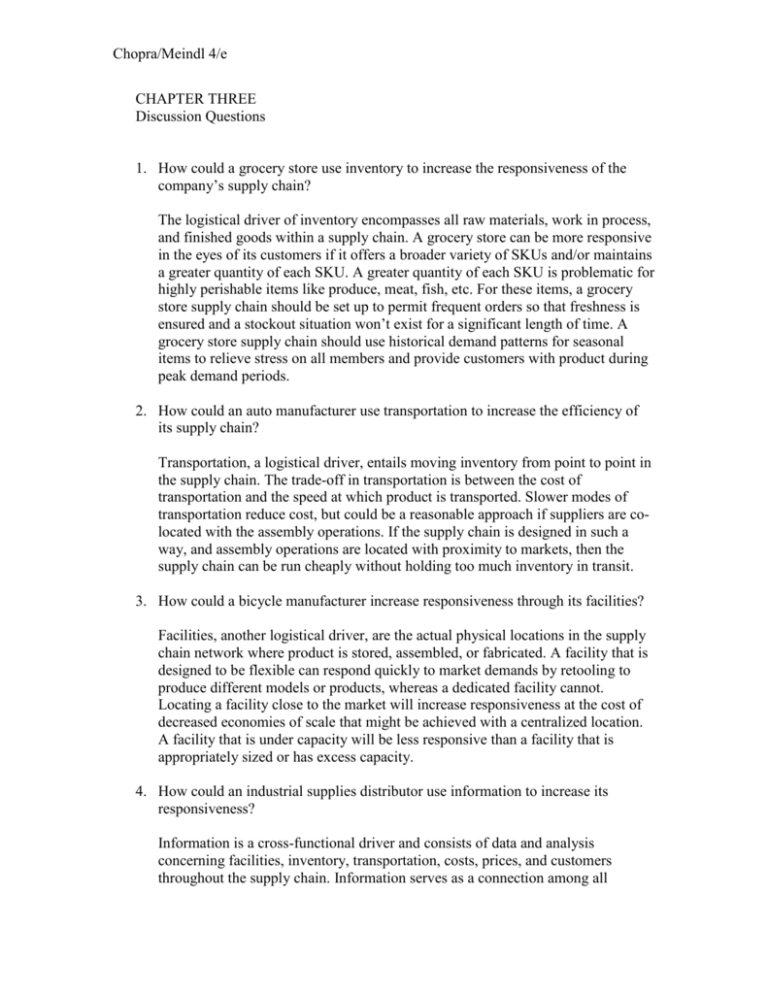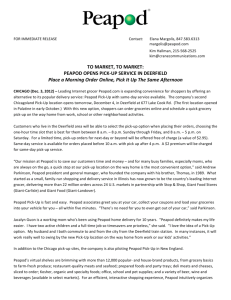Supply Chain Management - 4th edition
advertisement

Chopra/Meindl 4/e CHAPTER THREE Discussion Questions 1. How could a grocery store use inventory to increase the responsiveness of the company’s supply chain? The logistical driver of inventory encompasses all raw materials, work in process, and finished goods within a supply chain. A grocery store can be more responsive in the eyes of its customers if it offers a broader variety of SKUs and/or maintains a greater quantity of each SKU. A greater quantity of each SKU is problematic for highly perishable items like produce, meat, fish, etc. For these items, a grocery store supply chain should be set up to permit frequent orders so that freshness is ensured and a stockout situation won’t exist for a significant length of time. A grocery store supply chain should use historical demand patterns for seasonal items to relieve stress on all members and provide customers with product during peak demand periods. 2. How could an auto manufacturer use transportation to increase the efficiency of its supply chain? Transportation, a logistical driver, entails moving inventory from point to point in the supply chain. The trade-off in transportation is between the cost of transportation and the speed at which product is transported. Slower modes of transportation reduce cost, but could be a reasonable approach if suppliers are colocated with the assembly operations. If the supply chain is designed in such a way, and assembly operations are located with proximity to markets, then the supply chain can be run cheaply without holding too much inventory in transit. 3. How could a bicycle manufacturer increase responsiveness through its facilities? Facilities, another logistical driver, are the actual physical locations in the supply chain network where product is stored, assembled, or fabricated. A facility that is designed to be flexible can respond quickly to market demands by retooling to produce different models or products, whereas a dedicated facility cannot. Locating a facility close to the market will increase responsiveness at the cost of decreased economies of scale that might be achieved with a centralized location. A facility that is under capacity will be less responsive than a facility that is appropriately sized or has excess capacity. 4. How could an industrial supplies distributor use information to increase its responsiveness? Information is a cross-functional driver and consists of data and analysis concerning facilities, inventory, transportation, costs, prices, and customers throughout the supply chain. Information serves as a connection among all Chopra/Meindl 4/e members of the supply chain and operates within each member to facilitate internal operations. Accurate information can improve responsiveness by helping an industrial supplier better match supply and demand. Information that is gathered farther down the supply chain can be transmitted instantaneously and accurately to the supplies distributor. Instead of waiting for a human to call or FAX an order, the distributor can replenish inventory to the necessary levels or provide what is needed to fill the order as it is realized. 5. Motorola has gone from manufacturing all its cell phones in-house to almost completely outsourcing the manufacturing. What are the pros and cons of the two approaches? Sourcing is the set of business processes required to purchase foods and services. These decisions are crucial because they affect the level of efficiency and responsiveness that Motorola can achieve. The Motorola production system for their line of pagers was hailed as a breakthrough in mass customization, so it was somewhat surprising when Motorola outsourced cell phones.. Sourcing decisions should be made based on the total supply chain surplus; if a third party can help the chain achieve greater surplus, then the function is a prime candidate for outsourcing. Motorola was willing to give up some control and possibly some of its design talent and assembly expertise because it felt that the supplier could provide product of an appropriate level of quality with the responsiveness necessary. Products and services that are outsourced are rarely brought back inhouse and should never be tied too closely to the outsourcing party’s core competency. 6. How can a home delivery company like Peapod use pricing of its delivery services to improve its profitability? Pricing is the process by which a firm decides how much to charge customers for its goods and services. Pricing affects the customer segments that choose to buy the product as well as the customer’s expectations. Peapod can use everyday low pricing of its products to ensure stability in the supply chain, but can influence demand by varying the delivery charges. For example, by establishing a minimum order amount of $50 and charging $10 to deliver an order under $75, Peapod provides an incentive for a customer to pile on additional items to save on per unit shipping. An order over $100 incurs a delivery fee of $7, which is the lowest delivery charge for a residential customer. Peapod also varies delivery charges by time of day; evening delivery times on weekdays and morning deliveries on Sunday within narrow windows cost an extra dollar, wider delivery windows are $1 less. The delivery latitude allows Peapod’s delivery drivers to schedule more efficiently thereby increasing profitability. Chopra/Meindl 4/e 7. What are some industries in which products have proliferated and life cycles have shortened? How has the supply chains in these industries adapted? The authors cite the example of running shoes increasing from five styles in the early 70s to almost 300 by the late 90s. Other products that have seen an explosion in variety include personal electronics, beverages, snack and prepared foods, entertainment, tires, and personal services. Supply chains have leveraged information systems, recognized the need to collaborate on product and process design, and supply chain execution. The supply chain stance has shifted towards a partnership orientation from a focus on price negotiations. 8. How can the full set of logistical and cross-functional drivers be used to create strategic fit for a PC manufacturer targeting both time sensitive and price conscious customers? The logistical drivers, facilities, inventory, and transportation, and the crossfunctional drivers, information, sourcing, and pricing, must be used in concert to achieve the appropriate balance of efficiency and responsiveness for the supply chain to be successful. A PC manufacturer that wants to deliver product both quickly and efficiently can make cost and time trade-offs among these drivers to achieve their goals. These trade offs across drivers afford more flexibility but require constant vigilance as the trade-offs within each driver change. In addition, some drivers may be altered more easily, e.g., order quantity and transportation media, than other drivers, e.g., location and sourcing. The trade-offs within each driver are summarized in the table: Driver Facilities Inventory Transportation Information Sourcing Pricing More Responsive Multiple Plants Flexible Plants Higher Inventory Higher Speed Accurate Real Time Transmission Responsive supplier Differential Pricing More Efficient Single Plant Dedicated Plant Lower Inventory Lower Speed Less Accurate Batched Transmission Efficient supplier Everyday Low Pricing






